
Best Interior Finish for a Concrete Pool: Plaster vs. Pebble vs. Tile
Installation & Construction | Options and Accessories | Swimming Pool Design | Concrete Pool Information
Here at River Pools, we care about your skincare routine. Well, for your feet.
If you already have a concrete or gunite pool—or have ever been in one—you know that its surface chafes. Plain old plaster may look classy, but the scrapes on your skin do not. It’s even worse for kiddies, who need water shoes. To save yourself some Neosporin, you may want to consider upgrading the interior finish.
As a refresher, here are the most common interior finishes for a concrete pool:
- Plaster (the standard)
- Aggregate
- Tile
Plaster Finish
What’s it made of?
Plaster is a mix of white cement, white sand or marble aggregate, and water.
The pool builders apply the plaster to the concrete pool structure using a flat, round-edged trowel (see image below).
Although usually white, plaster can be dyed different colors.
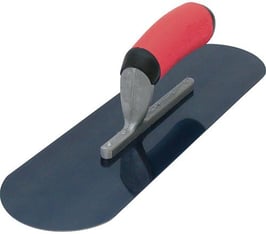
What are the pros and cons of plaster?
Advantages:
Plaster is relatively inexpensive.
Plaster is the iconic pool look. It’s classy and simple.
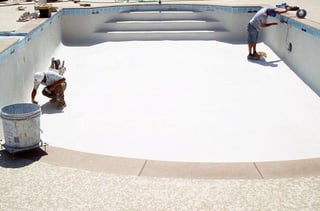
White plaster on a concrete pool
Disadvantages:
As with most concrete pool finishes, plaster is rough to the touch.
Plaster accommodates algae, so it requires surface maintenance every week and acid washing every 3-5 years.
Standard plaster shows trowel marks more easily than an aggregate finish.
Plaster can also crack, stain, etch, and scale if the water chemistry is incorrect or if you neglect maintenance.
Colored plaster often streaks, mottles, or otherwise changes or loses its dye.
Plaster is the least durable of the interior finishes for concrete pools. It only lasts 5-10 years.
Aggregate Finish
What’s it made of?
To upgrade your pool aesthetic, you can opt to mix a material like pebbles with the cement instead of sand.
Once it’s all mixed in and applied to the pool, the builders spray or wipe off the top layer of plaster to reveal the pebbles.
Common aggregate materials:
- Pebbles
- Glass beads
- Quartz
An aggregate finish can be exposed or polished.
- Exposed aggregate: the aggregate is revealed whole, providing a bumpy texture.
- Polished aggregate: the aggregate is polished flat, providing a smooth texture.
For example, look at the difference between Stonescapes® Sand exposed aggregate finish and Hydrazzo® Sahara Sand polished aggregate finish.
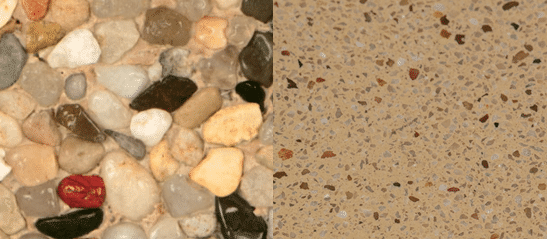
Exposed vs polished aggregate
What are the pros and cons of aggregate?
Advantages:
Aggregate finishes last longer than standard plaster. Quartz may last 7-12 years. Pebbles may last 10-20 years.
Glass beads are generally smaller than pebbles and softer on your feet.
Disadvantages:
The larger the exposed aggregate, the less comfortable it is to walk on. Big pebbles will hurt a bit; tiny glass beads are less of an issue.
Some people have had trouble with glass beads fading and discoloring over time, even within 6 years.
Tile Finish
What’s it made of?
Tile is typically made of porcelain (standard), stone, or glass. If you like, you can even mix the types together within the same pool.
Porcelain tile can be glazed, textured, or hand-painted for a fancier look. People typically use porcelain for waterline tile.
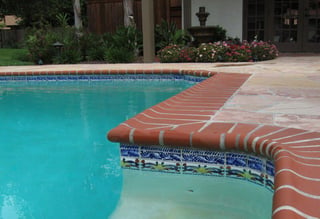
Porcelain tile along concrete pool waterline
The colors and textures of stone options like limestone, sandstone, and granite work well with a natural aesthetic.
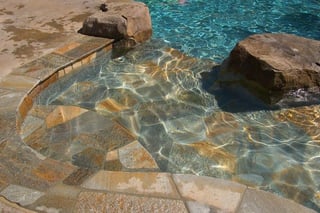
Stone tile in concrete pool
What are the pros and cons of tile?
Advantages:
Tile is the longest-lasting interior finish for a concrete pool.
Tile is easier to clean than exposed aggregate.
Porcelain/ceramic tile can be done as a DIY project if you’re very careful, although it may not be worth the headache.
Glass tile is nonporous and especially durable. It’s fire-, heat-, and UV-resistant, as well as frost-proof. It catches the sun and looks shiny.
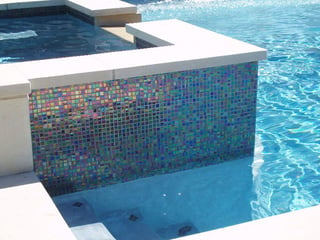
Glass tile on a concrete pool
Disadvantages:
Tile of any material is more expensive than plaster or aggregate—as in $4-$30 per square foot or more. That adds up to thousands more dollars for you to pull out of your back pocket.
- Porcelain is the least expensive material for tile.
- Stone is more expensive than porcelain/ceramic tile.
- Glass is the most expensive. Hugely so.
Tile can chip or crack.
Glass tile can have sharp edges if installed incorrectly.
Pros and Cons of Plaster, Aggregate, and Tile
| Plaster | Aggregate | Tile |
|
Pros:
|
Pros:
|
Pros:
|
|
Cons:
|
Cons:
|
Cons:
|
How much does resurfacing a concrete pool cost?
The cost of resurfacing a concrete pool depends on your region of the country, the size of the pool, and the material you choose.
Typically northern states are more expensive than, say, Florida.
As with any element of a pool, your interior finish will cost you more the bigger your pool is.
Plaster may cost $3.60-$4 per foot, while an aggregate material may cost $4.75-$5 per foot. Glass tile can cost $30-$50 per foot to install (and that estimate is in Florida, where pools are less expensive).
What other options do I have?
No matter your interior finish, concrete pools are rough to the touch and super expensive, but they aren't your only pool option.
Vinyl liner pools provide a smooth interior finish but don’t look as classy as concrete or fiberglass and require a lot of maintenance.
Fiberglass, however, has a smooth finish (the gelcoat) that requires almost no upkeep and looks gorgeous.
If you’re looking for a pool with a smooth, low-maintenance interior surface, you may want to consider a fiberglass pool. They’re high-quality, look lovely, and will last you for a long time.
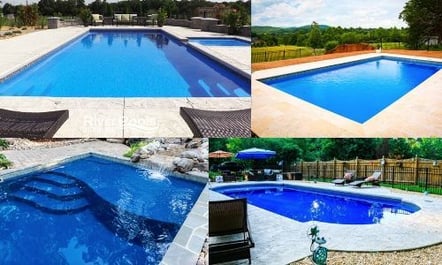
Take a look at our full catalog of models and visit our gallery to see what we can do for your pool project.
Wondering how much a fiberglass pool might cost? Contact us today to request pricing, and try out our pool pricing calculator tool below for a fast estimate:

Want to see about how much that cost will be with all your favorite pool accessories?
Use our Design and Price Tool to walk through your options and approximate price!
If you want an in-depth comparison of the three main inground pool types to help you with your research, be sure to download our free ebook before you go.
As always, if you have any questions for us, feel free to leave them in the comments.
Up Next:
Concrete Pool Basics: Pros, Cons, and How They’re Made
What's the Best Concrete Pool Design for Your Needs?
A Massive Review of Concrete Swimming Pools: Costs, Maintenance, Longevity, and More
Editor's note: This blog article was updated on January 14, 2020.
Editor's note: This article was updated on November 7, 2023.





